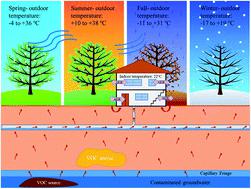当前位置:
X-MOL 学术
›
Environ. Sci.: Processes Impacts
›
论文详情
Our official English website, www.x-mol.net, welcomes your
feedback! (Note: you will need to create a separate account there.)
Comparison of modeled and measured indoor air trichloroethene (TCE) concentrations at a vapor intrusion site: influence of wind, temperature, and building characteristics.
Environmental Science: Processes & Impacts ( IF 4.3 ) Pub Date : 2020-02-21 , DOI: 10.1039/c9em00567f Elham Shirazi 1 , Gregory S Hawk , Chase W Holton , Arnold J Stromberg , Kelly G Pennell
Environmental Science: Processes & Impacts ( IF 4.3 ) Pub Date : 2020-02-21 , DOI: 10.1039/c9em00567f Elham Shirazi 1 , Gregory S Hawk , Chase W Holton , Arnold J Stromberg , Kelly G Pennell
Affiliation

|
There is a lack of vapor intrusion (VI) models that reliably account for weather conditions and building characteristics, especially at sites where active alternative pathways, such as sewer connections and other preferential pathways, are present. Here, a method is presented to incorporate freely-available models, CONTAM, and CFD0, to estimate site-specific building air exchange rates (AERs) and indoor air contaminant concentrations by accounting for weather conditions and building characteristics at a well-known VI site with a land drain preferential pathway. To account for uncertainty in model input parameters that influence indoor air chlorinated volatile organic compound (CVOC) concentration variability, this research incorporated Monte Carlo simulations and compared model results with retrospective field data collected over approximately 1.5 years from the study site. The results of this research show that mass entry rates for TCE are likely influenced by indoor air pressures that can be modeled as a function of weather conditions (over seasons) and building characteristics. In addition, the results suggest that temporal variability in indoor air TCE concentrations is greatest (modeled and measured) due to the existence of a land drain, which acts as a preferential pathway, from the subsurface to the granular fill beneath the floor slab. The field data and modeling results are in good agreement and provide a rare comparison of field data and modeling results for a VI site. The modeling approach presented here offers a useful tool for decision makers and VI practitioners as they assess these complex and variable processes that have not been incorporated within other VI models.
中文翻译:

蒸汽入侵地点模拟和测量的室内空气三氯乙烯 (TCE) 浓度的比较:风、温度和建筑特性的影响。
缺乏可靠地考虑天气条件和建筑特征的蒸汽入侵 (VI) 模型,特别是在存在活跃替代路径(例如下水道连接和其他优先路径)的地点。这里提出了一种方法,结合免费提供的模型 CONTAM 和 CFD0,通过考虑著名 VI 站点的天气条件和建筑特征来估计特定站点的建筑空气交换率 (AER) 和室内空气污染物浓度设有土地排水优先通道。为了解释影响室内空气氯化挥发性有机化合物 (CVOC) 浓度变异性的模型输入参数的不确定性,本研究结合了蒙特卡罗模拟,并将模型结果与从研究地点收集的大约 1.5 年的回顾性现场数据进行了比较。这项研究的结果表明,TCE 的大量进入率可能受到室内气压的影响,室内气压可以建模为天气条件(跨季节)和建筑特征的函数。此外,结果表明,由于土地排水沟的存在,室内空气 TCE 浓度的时间变化最大(建模和测量),土地排水沟充当从地下到楼板下方颗粒状填充物的优先通道。现场数据和建模结果非常一致,为 VI 站点提供了现场数据和建模结果的罕见比较。这里介绍的建模方法为决策者和 VI 从业者提供了一个有用的工具,因为他们可以评估这些尚未纳入其他 VI 模型的复杂且可变的过程。
更新日期:2020-02-21
中文翻译:

蒸汽入侵地点模拟和测量的室内空气三氯乙烯 (TCE) 浓度的比较:风、温度和建筑特性的影响。
缺乏可靠地考虑天气条件和建筑特征的蒸汽入侵 (VI) 模型,特别是在存在活跃替代路径(例如下水道连接和其他优先路径)的地点。这里提出了一种方法,结合免费提供的模型 CONTAM 和 CFD0,通过考虑著名 VI 站点的天气条件和建筑特征来估计特定站点的建筑空气交换率 (AER) 和室内空气污染物浓度设有土地排水优先通道。为了解释影响室内空气氯化挥发性有机化合物 (CVOC) 浓度变异性的模型输入参数的不确定性,本研究结合了蒙特卡罗模拟,并将模型结果与从研究地点收集的大约 1.5 年的回顾性现场数据进行了比较。这项研究的结果表明,TCE 的大量进入率可能受到室内气压的影响,室内气压可以建模为天气条件(跨季节)和建筑特征的函数。此外,结果表明,由于土地排水沟的存在,室内空气 TCE 浓度的时间变化最大(建模和测量),土地排水沟充当从地下到楼板下方颗粒状填充物的优先通道。现场数据和建模结果非常一致,为 VI 站点提供了现场数据和建模结果的罕见比较。这里介绍的建模方法为决策者和 VI 从业者提供了一个有用的工具,因为他们可以评估这些尚未纳入其他 VI 模型的复杂且可变的过程。









































 京公网安备 11010802027423号
京公网安备 11010802027423号